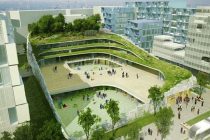Principles 2-4 of the Building Biology Principles concern Community Planning:
- Place dwellings so occupants are undisturbed by sources of man-made air, soil, water, noise and electro-pollution.
- Place dwellings in well-planned communities that provide ample access to fresh air, sunshine and nature.
- Plan homes and developments considering the needs of community, families and individuals of all ages.
You can download this fact sheet by clicking here.
How do we reconcile human health and ecological living in our cities today with the challenges of air, land and water pollution, the automobile, social problems, and zoning restrictions?
How do we define and create “well-planned” communities?
How can we meet the needs of community, families and individuals of all ages?
At the time of the original building biology writings in the 1970’s city planning theory had resulted in a new sort of ailment. The worst slums of the industrial revolution (at least in Western Europe and North America) had been successfully sanitized through slum clearing, and the implementation of draconian zoning laws. But the post war cities now suffered from a new form of ailment characterized by sterility and alienation. Zoning laws and city plans based on the automobile created great separations between work, schools, shopping and homes. Dominated by the implementation of unproven and simplistic theories of urban renewal that were widely adopted, the very fabric that makes a great city great was completely ignored. Decades later these experiments were unanimously declared to be failures.
The Building Biology recommendations for city planning can be summed up in a single sentence: Through appropriate urban planning, transform cities from soulless landscapes and restore them in to life-sustaining and life-affirming centers of human and environmental sustainability.
There are six main areas that Building Biology addresses and underlying all is the holistic approach to human health and planetary ecology from the scale of individual homes as well as to the communities that surrounds them.
- Create comprehensive, place-specific urban design guidelines-The key phrase here is “place-specific”. Cities, because they are the creation of mankind, originate in and are intrinsically connected to the nature of the place in which they are located. This is the foundation of what makes a City a unique and special place. Building Biology calls for an honoring of the place and the past as we move forward.
- Reinstate and reinforce the vitality of public space: By the 1970’s, much of the vitality of urban centers had been drained as people and the tax base they contributed fled from unlivable cities to the suburbs. It is common to find, in ailing cities, a central business district, devoid of night activity in a landscape filled with lifeless institutional buildings, expressions of financial might rather than human scale with streets too dangerous to be in after hours.
- Green the city by inviting nature back in: Humans have an elemental connection with nature and feel a sense of well-being when surrounded by plant life.
- Reduce the negative impacts of vehicular traffic: Vehicular-centric city design has resulted in loss of human scale, visual blight, noise, air and ground pollution, isolation of the young, the old and the poor who do not have access to personal transportation and dependency of fossil fuels. The traffic-dominated street does not work well as a place of communication and interaction.
- Manage rainwater ecologically, as a natural system: Water usage in the United States and Canada is staggering as compared to other parts of the world. According to the EPA, the average family of four can use 400 gallons of water (1,514 liters) every day, and, on average, approximately 70 percent of that water is used indoors.
- Integrate renewable energy and energy reduction into city planning: Strategies for reducing the energy requirements and dependence on technologies for individual buildings are discussed in depth in the IBE 215 seminar and manual. Planning for the wise use of natural and renewable resources on a community-wide level will have the greatest impact.
The Building Biology criteria for community planning, although formulated decades ago, are even more relevant today as our cities continue to grow in number, density and size and an increasing number of their inhabitants face the problems of unhealthy and stressful living conditions.
Want to learn more on this issue? Click the comprehensive online course, here below.


